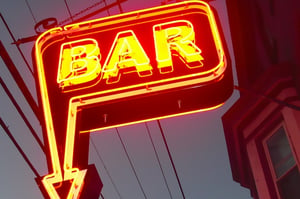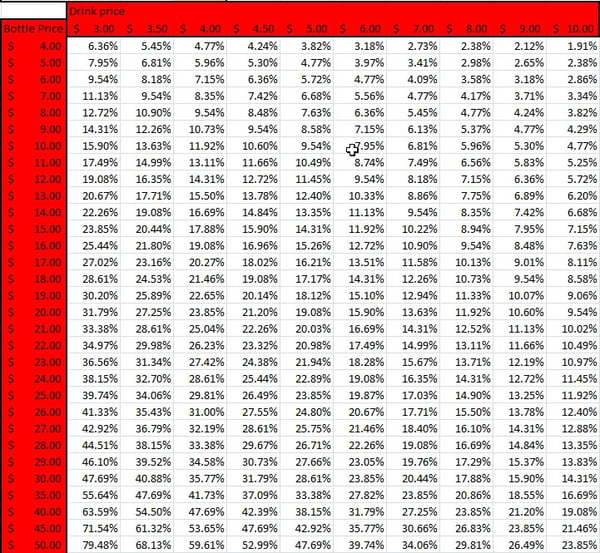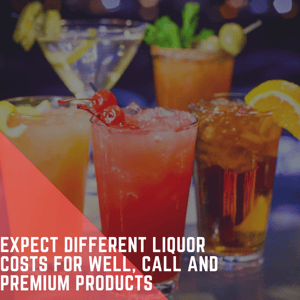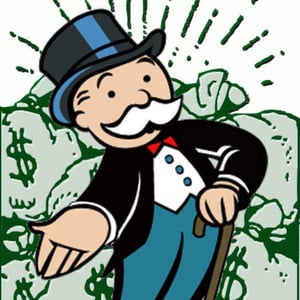 Bar-i recently set up a new client with our liquor inventory system. This is a no-nonsense neighborhood bar – it has a down-home feel where people go to catch up with friends and play pool. Their target demographic are people who like more traditional drinks: simple cocktails such as Jack and Coke, well drinks, and really cold beer.
Bar-i recently set up a new client with our liquor inventory system. This is a no-nonsense neighborhood bar – it has a down-home feel where people go to catch up with friends and play pool. Their target demographic are people who like more traditional drinks: simple cocktails such as Jack and Coke, well drinks, and really cold beer.
While we were making some updates to our new client’s POS system, they indicated that they hadn’t looked at their cocktail pricing in a while. The owner asked if we could provide her with a cheat sheet that would help them price drinks based on the purchase price of their bottles. In order to accommodate this request, we created a drink pricing lookup table for them to use.
This lookup table essentially allows you to determine the right drink price to achieve your target liquor cost for the product being served. You can use this table in order to be more strategic about your pricing decisions for cocktails.
Keep in mind that this is a basic table that only works for single liquor drinks. If you’re interested in a tool that will help you be more strategic with your pricing of draft beer and wine products, you can download our free liquor cost calculator.
How to Use our New Drink Pricing Lookup Table
The vertical axis of the table lists your purchase price for a bottle of liquor. The horizontal axis of this table lists the price of a drink. The percentages listed throughout the rest of the table represent the liquor cost for a drink. Simply look for the target liquor cost you’d like to achieve and you can figure out the ideal price to charge for a drink based on the purchase price of the bottle.

The table has the following settings:
- It can work with 1-liter bottles and 750 ml bottles
- It can work with any pour size for drinks
- It can factor in local sales tax
The default settings for the table are as follows:
- 1-liter bottle
- 5 oz. drink size
- 7% sales tax
By downloading the table, you’ll have the ability to manipulate these settings to reflect your unique needs. You can shift the bottle size to 750 ml. You can also adjust the drink size to price out shots, cocktails, doubles, rocks or any other portion size you serve at your bar. You can even adjust the local sales tax to reflect the tax laws in your state.
Let’s look at a couple of examples to demonstrate how this table is used (based on the default settings):
- Pricing a well drink – If you purchased a bottle for $7 and sell $4 well drinks of this product, you’ll achieve an 8.35% liquor cost for this product
- Pricing a call drink – If you purchased a bottle for $25 and sell $6 call drinks of this product, you’ll achieve a 19.87% liquor cost for this product
- Pricing a premium drink – If you purchased a bottle for $50 and sell $10 premium drinks of this product, you’ll achieve a 23.85% liquor cost for this product
Audit Your Current Pricing Strategy
This table is meant to be a quick-check tool that you can use to do a basic audit of your current pricing. If you haven’t thought about your pricing strategy in a while, this can help you make sure you’re actually pricing your drinks in a way that will help you achieve your desired liquor cost.
We recommend that you take approximately 10 different drinks at varying price points served at your bar and look to see where the liquor cost falls on this table based on your current prices. This will help you understand why your liquor cost isn’t where you’d like it to be.
Expect Vastly Different Liquor Costs for Well, Call and Premium Drinks
 In general, well drinks (which have a low purchase cost) will typically have the lowest liquor cost. Since well drinks are typically sold in high volume, this will help you bring down your overall liquor cost.
In general, well drinks (which have a low purchase cost) will typically have the lowest liquor cost. Since well drinks are typically sold in high volume, this will help you bring down your overall liquor cost.
You should always keep the following guidelines in mind when determining the price of well, call and premium drinks:
- Price your well drinks in a way that keeps the liquor cost for these products lower than your target overall liquor cost.
- Call drinks should be priced in a way that keeps the liquor cost for these products roughly at your target overall liquor cost.
- With premium drinks, it will generally be difficult to price them high enough to maintain a low liquor cost. These products will almost always have a higher liquor cost than your overall target figure.
Pricing Strategy Tip: Think about Dollars Made instead of Liquor Cost
Just keep in mind that liquor cost refers to the margin you make on each drink, not the total profits you earn. While well drinks have a good margin, the actual profit you make on each drink is relatively low. Ideally, you should be more concerned with how many dollars you make from each drink than the margin for the product.
If you buy a bottle of premium liquor for $50, you’re going to have a significantly higher liquor cost than you will for a well product (almost three times higher). However, you’re also making a much larger profit on the premium drink.
 There are 22.5 servings in a liter bottle (at a 1.5 oz. serving size). If you get 22 drinks out of this premium liquor bottle and each drink costs you just under $2, you’re making approximately $8 per drink when you sell premium cocktails for $10. When you sell a $4 well drink, you’re not making anywhere near an $8 profit per drink. Even though these premium liquor products are raising your overall liquor cost, they’re also bringing in significantly higher profits than well and call drinks.
There are 22.5 servings in a liter bottle (at a 1.5 oz. serving size). If you get 22 drinks out of this premium liquor bottle and each drink costs you just under $2, you’re making approximately $8 per drink when you sell premium cocktails for $10. When you sell a $4 well drink, you’re not making anywhere near an $8 profit per drink. Even though these premium liquor products are raising your overall liquor cost, they’re also bringing in significantly higher profits than well and call drinks.
It’s important to be strategic with your pricing decisions. You want to price your drinks in a way that entices people to order the higher-end liquors since you make a larger profit on these drinks. Therefore, it’s ok to price call and premium drinks more aggressively even if it raises your liquor cost slightly. The tradeoff for this higher liquor cost is the ability to sell more of these drinks and maximize your profits.
Actual Liquor Cost vs. Theoretical Liquor Cost
In theory, if your purchase cost for a drink is $1 and you sell it to customers for $5, your liquor cost will be 20% (this is your theoretical liquor cost). However, it’s important to understand that this isn’t the true liquor cost for the drink. You won’t get the entire $5 price due to sales tax. To determine your actual liquor cost, you need to deduct the sales tax from the amount of money you’re making on each drink.
You also need to account for the impact of missing product on your actual liquor cost. Missing product can occur due to a variety of factors, including:
Anytime you sell a drink at lower than full price, it will bring down your average retail sales and raise your liquor cost. All of the factors listed above will have this effect on your actual liquor cost. These factors are simply part of the cost of running a bar business. However, it’s important to establish a level of discounted/missing product that you consider to be acceptable. Otherwise, you’ll be sacrificing profits for no reason.
Determine Your Achievable Liquor Cost
For most bars, their actual liquor cost is higher than it should be. While it’s almost impossible to reach your theoretical liquor cost due to the factors discussed above, there is generally a level between your actual liquor cost and your theoretical liquor cost that you should aim for. We call this figure your achievable liquor cost.
Your achievable liquor cost should be a figure that is realistic to maintain after factoring in the impact of the inevitable missing product. Arriving at this figure requires the use of a sophisticated inventory system. By creating recipes for every drink on your POS system, you can calculate what your liquor cost would be if these drinks were actually poured at the proper portion all the time. This would be your target to shoot for moving forward.
Achievable liquor cost isolates the effect of missing product while also factoring in the other real-world items such as sales tax or comps that prevent you from reaching the theoretical liquor cost.
When you account for your promotions, discounts and other items which result in drinks being served at less than full price, you can arrive at a realistic target liquor cost that will be sustainable for your bar while allowing you to maximize your profits. This target will ultimately involve reducing missing product to as close to 0% as possible.
Schedule a Consultation
To learn more about how Bar-i can help you streamline your operations and maximize profits, please contact us today to schedule a free consultation. We serve bars nationwide from our offices in Denver, Colorado.




-1.png)